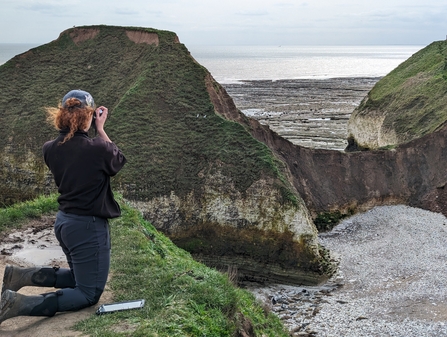During her December survey, Beth spotted an adult female seal with an orange tag on her flipper. Tags come in a range of colours and sizes and are used by research units & rehabilitation centres to help identify seals should they be seen again in the future. Following some detective work, we received an exciting email from the Seehundstation Friedrichskoog rehabilitation centre in Germany: Seal 2895 had made her way to East Yorkshire!
A Surprise Visitor from Germany: Seal 2895 Makes Waves on the East Yorkshire Coast
Grey seal with tag 2895 (c) Beth Thompson

Beth counting seals on the beach (c) Cate Holborn
The Journey of Seal 2895
Seal 2895 was born on Heligoland, a small island off the northwest coast of Germany, sometime between December 2020 and January 2021. Her story began with a rocky start — she was admitted to Seehundstation Friedrichskoog in March 2021, weighing just 12.9 kilograms. Thanks to expert care and rehabilitation, she thrived and was released back into the wild just two months later in May, tipping the scales at a healthy 52.8 kilograms.
Since her release, she had not been officially recorded until Beth's remarkable sighting in December 2024, making her about four years old at the time of the encounter.

Grey seal with tag 2895 (c) Beth Thompson
A Seal with Wanderlust
Grey seals are known for their impressive ability to cover vast distances and will often travel over 100km in search of food. However, seeing one journey from Germany to the shores of East Yorkshire, a straight-line distance of 320 miles (515km), is a testament to the species' resilience and adaptability!
This also illustrates just how connected our seas are, with wide ranging species like grey seals using large areas of the wider North Sea, far beyond our shores. It’s vital to ensure that cohesive policies are in place to protect our seas and the species that use them, not just at home but further afield too.
Why This Matters
Seal sightings and tag identifications contribute valuable data to marine conservation efforts. They help researchers understand the health of seal populations, their movement patterns, and the success of rehabilitation programs like the one at Seehundstation Friedrichskoog.
Seal 2895's appearance along the East Yorkshire coast provides a heartwarming reminder of how interconnected our world is, even for marine life. Her journey serves as a beacon of hope for conservation efforts and a testament to the dedication of those who work tirelessly to protect wildlife.
What’s Next for Seal 2895?
Since Beth’s sighting in December, Seal 2895 hasn’t been spotted again - but that doesn’t mean she’s not out there thriving. Seals can be elusive, and spotting tags is tricky - depending on the right timing, angles and conditions. Wherever she is now, Seal 2895's remarkable journey is a story worth celebrating
Here’s to hoping she continues her adventures safely, perhaps delighting future surveyors with another surprise appearance along the coast.
